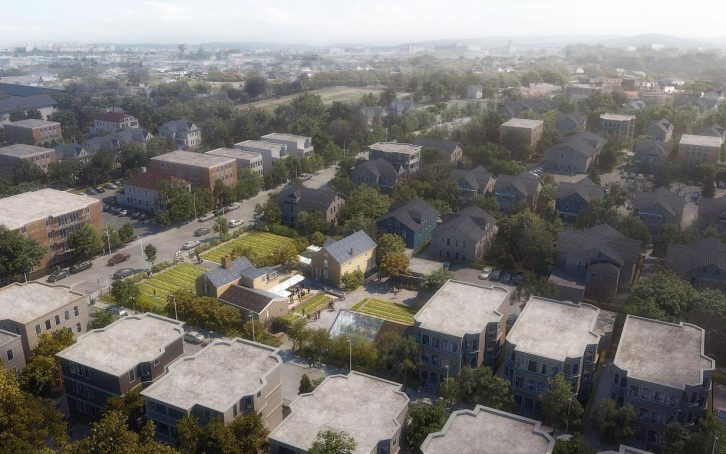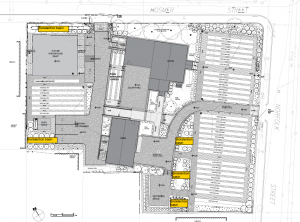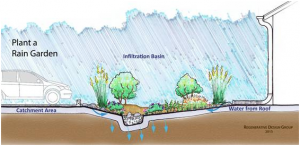
April 18, 2017 Where Does the Rainwater Go? Cleaner, Safer Water Management at the Fowler Clark Epstein Farm
Nitsch Engineering’s Jessica Yarmarkovich, PE, LEED AP ND, ENV SP, Project Engineer, and Steven Ventresca, PE, LEED AP BD+C, Project Manager, prepared this post to describe the intricate and challenging process of designing a rainwater management system for the Fowler Clark Epstein Farm that contributes to region’s efforts to provide cleaner, safer water and protect our natural bodies of water from contamination.
The streets of Boston were paved in the late 1700s and this literally paved the way for the Industrial Re
 volution to transform Boston through advances in transportation, economy, innovation, medicine, and society. However, this also contributed to Boston’s history of poor water quality in the harbor and natural waterways. Paved roadways create impervious surfaces which have three major consequences:
volution to transform Boston through advances in transportation, economy, innovation, medicine, and society. However, this also contributed to Boston’s history of poor water quality in the harbor and natural waterways. Paved roadways create impervious surfaces which have three major consequences:
Consequence 1: Rainwater can no longer naturally infiltrate through these surfaces to the below-ground aquifer and replenish the groundwater tables, which is a crucial natural resource. Maintaining pre-development groundwater levels is also important within certain parts of Boston, like Back Bay, to protect the wood pile foundations of buildings from rotting.
Consequence 2: Rainwater flowing from the impervious surfaces carries away contaminants such as bacteria, phosphorus, lead, and Polychlorinated Biphenyls (PCBs), according to the Environmental Protection Agency (EPA). These pollutants discharge into water bodies, such as the Charles River, degrading river conditions, poisoning fish, and increasing algal growth.
Consequence 3: Impervious areas prevent groundwater infiltration, causing the volume of rainwater flowing off site (the run-off volume) and the rate at which rainwater flows off site (the run-off rate) to increase significantly. This can have a detrimental effect on bodies of water. The City of Boston, along with many cities within the United States, has historically constructed Combined Sewer Overflows (CSOs). CSOs combine sewage and rainwater in one culvert and direct the water to a treatment facility and include an emergency overflow system to a nearby water body. This polluted sewage rainwater mix is more likely to overload the system and overflow into water bodies, such as the Boston Harbor, because of the increased run-off volume and rate of rainwater discharging to the City’s pipe systems.
Boston has already demonstrated leadership through decades of sewer separation projects, which have helped eliminate the discharge of untreated wastewater to Boston Harbor. These sewer projects separate the combined sewer pipe into a designated sewage pipe that flows to the Deer Island Wastewater Treatment Facility and a different rainwater pipe that flows to a water body. Despite these efforts, the Charles River, Neponset River, and Boston Harbor remain adversely impacted during large rain events because of polluted urban rainwater run-off.
There is a Total Maximum Daily Load (TMDL) set in place by the Environmental Protection Agency (EPA) for pollutants associated with rainwater discharges, including phosphorus and fecal coliform bacteria for the Charles River Watershed. According to the Massachusetts Office of Energy and Environmental Affairs, a TMDL is the greatest amount of a pollutant that a waterbody can accept and still meet water quality standards for protecting public health and maintaining the designated beneficial uses of those waters for drinking, swimming, recreation, and fishing. In order to comply with these requirements, the Boston Water and Sewer Commission (BWSC) has set in place goals and regulations for Boston projects as one part of a multi-pronged approach to address phosphorous discharges associated with rainwater run-off.
The Fowler Clark Farm (the Farm) is located within the Charles River Watershed, which means rainwater run-off from the Farm eventually flows into the Charles River through a network of underground pipes. You may have seen these “Don’t Dump” signs in the area before:
The Regenerative Design Group (the landscape architect) and Nitsch Engineering (the civil engineer) worked with BWSC to design a rainwater management system for the Farm that contributes to Boston?s efforts to provide cleaner, safer water.
The Farm?s rainwater management system has two goals:
Goal 1: Get rainwater back into the ground through groundwater infiltration techniques.
Goal 2: Treat the water that cannot be infiltrated into the ground to reduce the potential for pollutants (primarily sediment and phosphorous) entering the Citys pipe networks and eventually flowing into the Charles River.
Nitsch Engineering developed a rainwater management system for the Farm that includes several Low Impact Development (LID) storm water features to meet these goals and BWSC?s regulations. The rainwater management system includes multiple infiltration trenches and bioretention basins. The infiltration trenches promote groundwater infiltration through clean stone and a filter fabric. The bioretention basins, often referred to as raingardens, treat rainwater through filtration and nutrient uptake by the plants, promote groundwater infiltration, and serve as visual amenities and educational opportunities. In fact, some of the bioretention basins on the Farm will not only serve as rainwater treatment devices, but will also be used to grow plants and edible blueberries! An example of a bioretention basin section is shown below.
The infiltration trenches and the bioretention basins are designed to infiltrate and store the volume of water produced from a typical storm event, which is about one inch of rainfall. Run-off from the first inch of rainfall has the highest sediment and phosphorous pollutant load; by infiltrating the run-off from this first inch, the Farm will significantly reduce the amount of pollutants flowing into to the City’s pipe networks. The Farm will also reduce the run-off volume and rate of the water discharging from the site into the City’s pipe network system.
In a typical rainfall event there is expected to be zero rainwater discharging from the Farm into the City’s system. The rainwater will be infiltrated into the ground or stored in the rainwater management system. During a larger rainfall event, the rainwater run-off volume and rate is expected to be about half of what it is today, and the water that does discharge into the City’s system, and ultimately into the Charles River, will be much cleaner than it is today.
We hope that you can stop by to see some of these storm water systems for yourself!



